The Easter Egg
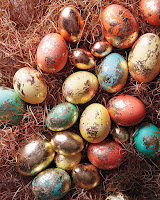 Easter eggs are specially decorated eggs given out to celebrate the Easter holiday or springtime.
Easter eggs are specially decorated eggs given out to celebrate the Easter holiday or springtime.
It is the influence of the traditional spring rites that made Easter so egg-special. And myths coming down to us from an incredibly distant past have shown man’s relationship with the egg to be very deep seated one. There are several versions of how eggs came to be associated with Easter, however one popular one is that they represent new life, the beginning of spring when nature once again is awakening and sprouting with new life. Soft green flower growth, trees budding, baby rabbits and lambs are born and so on. There are definitely a lot of religious associations from pagan to Christian and more, and each one seems to relate a story about rebirth. In Greece it is customary that we dye eggs on Good Thursday, in preparation for Sunday, when we get to eat the dyed eggs after fasting for lent for 40 days. Traditionally all eggs were painted a deep red to represent Christs blood but nowadays they can be seen in many more vibrant colors. None the less, below are a few ways of having fun while dying your own eggs this springtime. Most made with materials found around the house. Inexpensive and Fun!Foiled Eggs
Watercolor Easter Eggs
Dampen a boiled egg under water, then apply washable watercolor paint to the wet shell using a small brush; you want the colors to bleed slightly on the damp surface. If you’d like the design to spread out more, lightly brush on more water. Pro Tip: Set your egg’s color by using a hair dryer on the lowest setting; move the dryer in small circles and hold it at least 6 inches from the egg for about 10 seconds.
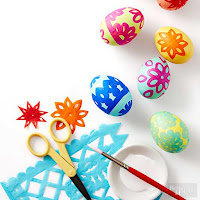 Tissue Paper Eggs
Tissue Paper Eggs Create distinctive egg designs by cutting your own patterns from colorful tissue paper. Try decorative edges, floral looks, or basic zigzags. Brush a thin coat of decoupage medium onto an egg. Position the tissue paper cutouts and gently pat into place, starting in the center of a design and working your way out. Pro Tip: It’s easiest to start by applying one bigger piece to the center of the egg, then using smaller sections to fill in.
Marble Easter Eggs
Dye eggs a light base color; let dry. Mix up a batch of very dark dye and place it in a wide, shallow bowl. Stir in 1 Tbs. of a light-colored oil, such as canola or even melted margarine, to form swirls on the surface of the dye. Roll egg in dye mixture and pull out carefully with tongs after 3 seconds; pat gently with paper towels, then let dry. Pro Tip: Room-temperature eggs and dye work best for this technique. If your materials are too warm the oil can slip off, too cold and the dye won’t absorb.
Color Blocking Easter Eggs
Submerge a portion of each egg in a fairly concentrated dye of your choice and hold it very still for a few seconds. Let dry, then repeat using a different portion of the egg and a new color of dye. Experiment with different color combinations, overlapping portions of the egg and leaving parts of the shell free from dye. Let dry after adding each new layer of color.
Taping Easter Eggs
Snip rectangles, squares, and triangles from strips of electrical tape and apply the tape to shells. Dye the eggs; let dry. When eggs are fully dry, remove the tape to reveal geometric designs.
Stamping Easter Eggs
Dye eggs a pale base color. Press your fingertip into a nontoxic ink pad (VersaMark Watermark Stamp Pad, $10; joann.com), then lightly press and roll your finger on the eggshell to create dots. Allow ink to dry.
Ombré Easter Eggs
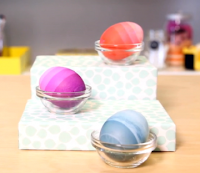 Create a beautiful ombré effect on Easter eggs with one simple trick. In a glass measuring cup place a bottle lid on the bottom of the cup and balance eggs on lip. In another cup combine hot water, vinegar and egg dye (about 40 drops) up to the ¼ line, then slowly add dye to cup with egg until it covers 1/3 of the egg. Let sit for three minutes, then add more dye or hot water to the cup until it reaches the middle of the egg. Let sit another 3 minutes. Add more liquid to cover 2/3 of the egg and wait 3 mins. Remove egg with tongues and let dry on paper towel.
Create a beautiful ombré effect on Easter eggs with one simple trick. In a glass measuring cup place a bottle lid on the bottom of the cup and balance eggs on lip. In another cup combine hot water, vinegar and egg dye (about 40 drops) up to the ¼ line, then slowly add dye to cup with egg until it covers 1/3 of the egg. Let sit for three minutes, then add more dye or hot water to the cup until it reaches the middle of the egg. Let sit another 3 minutes. Add more liquid to cover 2/3 of the egg and wait 3 mins. Remove egg with tongues and let dry on paper towel.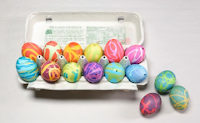 Rubber Cement Easter Eggs
Rubber Cement Easter EggsDrizzle on some rubber cement to create eye-catching Easter eggs. After making your design, let cement dry then immerse in dye for a few minutes. Remove egg with tongues onto paper towels and when dry remove rubber cement to reveal the design.
Source – http://www.parents.com/holiday/easter/crafts/creative-ways-to-dye-easter-eggs/
Onion peel & Herb dyed Easter Eggs
When boiling hard-cooked eggs for Easter, a popular tan colour can be achieved by boiling the eggs with onion skin. Try red onion skin and brown for different effects. Put the skins of three or four yellow onions in a pan with the eggs, cover with water, add a tablespoon of white vinegar and boil as you normally would. It works best to put a layer of onion skin down first, then place the eggs on top of it and cover them with more skin. You can also use herbs and flowers to creative designs. For example put the egg inside an old knee-high stocking with a sprig of something botanical — bindweed or parsley works great, as do flower blossoms (and flowering weeds) — and secure the stocking tight against the egg with a rubber band. Cut off about half the stocking before getting started, because it makes finagling the plant into place easier. Also, once the water has come to a boil and you turn the heat down or off, let the eggs soak in the onion skin water until it cools.
http://www.gjsentinel.com/lifestyle/articles/easter-egg-experiment-whipped-topping-onion-skin-b
 Easter eggs are specially decorated eggs given out to celebrate the Easter holiday or springtime.
Easter eggs are specially decorated eggs given out to celebrate the Easter holiday or springtime.  Create a beautiful ombré effect on Easter eggs with one simple trick. In a glass measuring cup place a bottle lid on the bottom of the cup and balance eggs on lip. In another cup combine hot water, vinegar and egg dye (about 40 drops) up to the ¼ line, then slowly add dye to cup with egg until it covers 1/3 of the egg. Let sit for three minutes, then add more dye or hot water to the cup until it reaches the middle of the egg. Let sit another 3 minutes. Add more liquid to cover 2/3 of the egg and wait 3 mins. Remove egg with tongues and let dry on paper towel.
Create a beautiful ombré effect on Easter eggs with one simple trick. In a glass measuring cup place a bottle lid on the bottom of the cup and balance eggs on lip. In another cup combine hot water, vinegar and egg dye (about 40 drops) up to the ¼ line, then slowly add dye to cup with egg until it covers 1/3 of the egg. Let sit for three minutes, then add more dye or hot water to the cup until it reaches the middle of the egg. Let sit another 3 minutes. Add more liquid to cover 2/3 of the egg and wait 3 mins. Remove egg with tongues and let dry on paper towel.


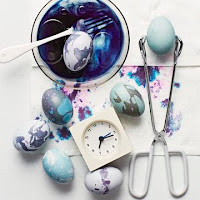
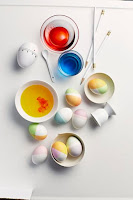



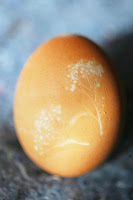
Glad you enjoyed it. Thank you. Will keep in mind to post about Reiki.